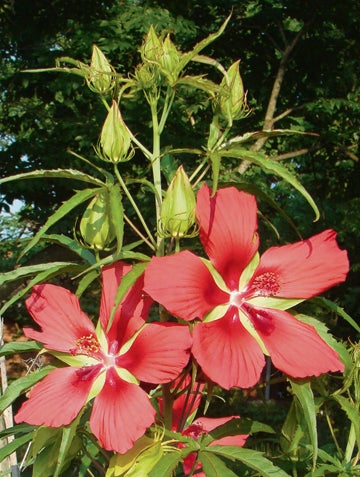Consumer Qs: onion hoe; Texas star hibiscus; growing coffee
Published 4:00 pm Thursday, May 26, 2016

- Scarlet swamp hibiscus, also called Texas star hibiscus and other names, is a beautiful native wildflower and an excellent garden perennial.
Q: What is an onion hoe?
A: An onion hoe is a hoe with a narrow blade originally designed for tending onions. The narrow blade allows for cultivation in tight spaces and between closely set plants. Before they were widely available commercially (and to save money), some onion farmers would modify a regular-sized worn-out hoe by removing the sides of the blade to make it vertically narrow. Today there are numerous styles on the market, including ones with blades that are narrow horizontally instead of vertically or that have half-moon blades. Many being sold today are small, hand-held types.
Although they are still called onion hoes, most never see an onion field. Gardeners who need a tool to work amid closely planted vegetables and flowers value these narrow-bladed hoes. They also weigh less than a standard hoe, a desirable attribute if you have a long row to hoe.
Q: What is the Texas star hibiscus?
A: Texas star hibiscus is one of the common names, albeit a misleading one, for Hibiscus coccineus, a beautiful hibiscus native to swampy areas of several southern states, but not to Texas. However, its five pointed sepals are visible in the areas between the petals and reminded someone of the Lone Star flag, hence the name. Other common names are swamp hibiscus, scarlet swamp hibiscus, scarlet rose-mallow, scarlet mallow, crimson rose-mallow, wild red mallow and scarlet hibiscus.
Whatever you want to call it, it is a versatile and beautiful perennial that ranges from four to as much as eight feet tall under good conditions and is a hummingbird favorite. Although it is native to wet areas and prefers moisture, it will tolerate regular garden soil. It does not like dry soils, however. A few good companion plants include canna, swamp sunflower, cardinal flower, turtlehead, ironweed, joe-pye weed, daylilies, Louisiana iris and copper iris.
Q: What are blister-fried peanuts?
A: Blister-fried peanuts are peanuts that are treated with a hot-water bath and then deep fried to give them a crunchy texture and their distinctive bubbly blisters.
Q: Can we grow coffee in Georgia?
A: Since coffee is not winter hardy here, we would have to grow it in a greenhouse or as a houseplant. You may want to try it as a novelty or as an ornamental for its shiny leaves, flowers and, if you’re lucky, colorful fruits. Coffee plants are available from several mail-order sources if you don’t find plants at your local garden center.
If you have questions about services or products regulated by the Georgia Department of Agriculture, write Arty Schronce (arty.schronce@agr.georgia.gov) or visit the department’s website at www.agr.georgia.gov





